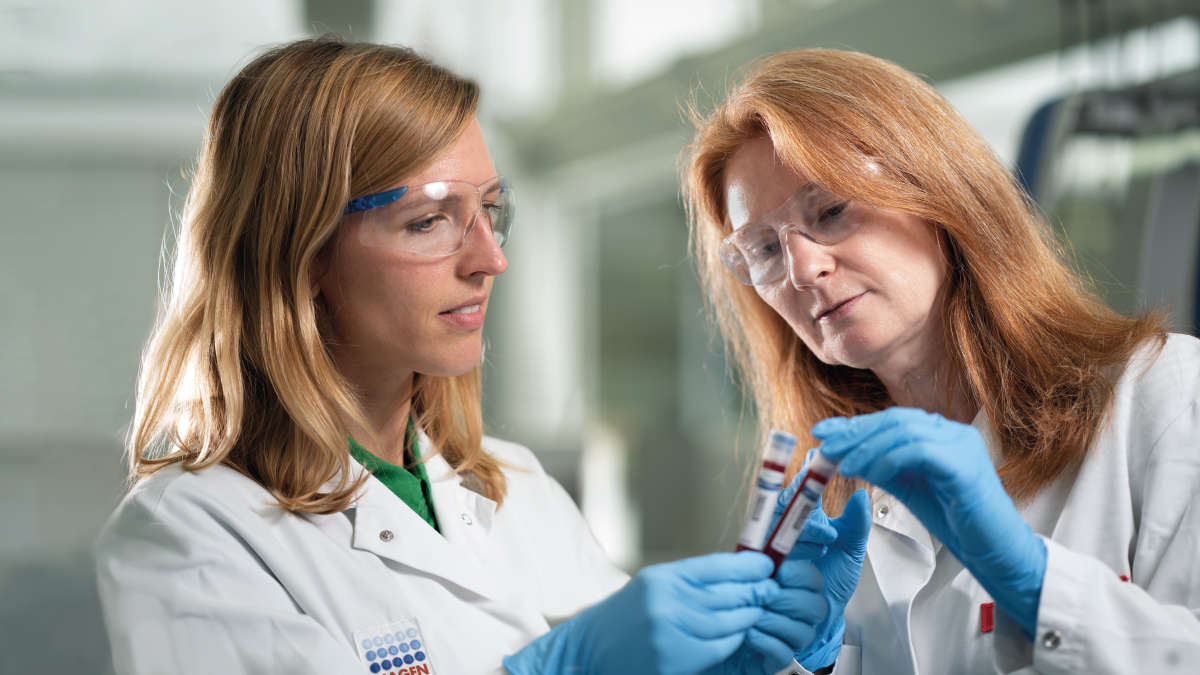
The synergistic relationship between dPCR and liquid biopsy
There’s a new movie out about how Nike managed to sign Michael Jordan to develop their widely successful Air Jordan sneakers and clothing line. At that time, Nike was still struggling to establish itself and Michael Jordan was just starting out in the NBA with no guarantees of a successful career. The collaboration was very fruitful for both Michael Jordan and Nike, as the two grew and evolved together. Each helped the other to dominate their respective fields.
These types of synergistic relationships are rare finds, but they occur even in science. Take DNA sequencing and PCR. Both methods were born within a decade of each other, both were developed quickly, and both were used together to achieve key findings in genomics, molecular biology and diagnostics.
Here is another more recent example: Liquid biopsy and digital PCR. Advances for both liquid biopsy in oncology and digital PCR were first made in the 1990s (1,2). The popularity of both methods skyrocketed in 2010 and onwards, thanks to the development of new instruments and chemistry.
The similarities don’t end there. Just like PCR and DNA sequencing, liquid biopsy analysis and digital PCR don’t just share a common history. They also share a common workflow. And just as how Michael Jordan and Nike helped each other out, cancer research with liquid biopsy and the digital PCR approach make the potential management and detection of cancer more readily achievable.
Let’s explore this synergistic relationship between digital PCR and liquid biopsy in more detail. As a refresher, digital PCR partitions the sample mix into thousands of separate reactions to provide absolute quantification of nucleic acids without standards or curves. With digital PCR, you can evaluate a number of known and selected biomarkers with high sensitivity, limited cost and short turnaround times (3).
Liquid biopsy is a non-invasive method for analyzing cell-free DNA (cfDNA), circulating tumor DNA (ctDNA), circulating tumor cells (CTCs) and extracellular vesicles in blood or other fluids. The method is currently used to detect relevant mutations for the following research applications (4,5):
- Assessment of therapy response
- Tumor characterization
- Detection of early cancer
- Evaluation of residual disease after treatment
- Assessment of difficult-to-biopsy cancers
- Analysis of tumor heterogeneity
- Mutation detection in cancer relevant genes
- Early detection of response or resistance during treatment
Now that we know what liquid biopsy is used for, let’s explore some of its advantages and limitations.
Liquid biopsy is safe and easy to collect and the method offers more representative sampling of cancer biomaterials than tissue biopsy. But despite its clear advantages, a major hurdle of liquid biopsy is that tumor-derived DNA is present in very small amounts. To differentiate ctDNA from the DNA of normal cells, extremely sensitive methods are required to detect cancer-specific mutations (5).
Several such methods and their variations are widely used in liquid biopsy. These include digital PCR, quantitative PCR and next-generation sequencing (NGS). Each of these methods comes with its own benefits and limitations. Digital PCR, in particular, can detect limited targets per assay, but with extremely high sensitivity, low running costs and fast turnaround times (5). In addition, methods such as drop-off digital PCR have been developed to detect a greater number of mutations in a single reaction (6).
It’s worth mentioning that just like Michael Jordan needed his teammates to win games, dPCR can work together with other methods to optimize liquid biopsy analysis. A great example of a complementary relationship in nucleic acid analysis is the combination of dPCR and NGS. If you’d like to learn more, check out our blog post on how dPCR and NGS can be used together in research and a webinar on the use of dPCR for NGS library quantification.
Back to liquid biopsy analysis. Regardless of how you use digital PCR for liquid biopsy applications, such as biomarker validation, here are several tips you could use to ramp up your performance (7):
- To increase throughput and obtain results faster, consider a fast (2 hours or less), user-friendly workflow
- A good way to minimize the subsampling error is to use a dPCR system with a high limit of detection (LOD)
- To improve the accuracy of your detection of mutation copies, try using specifically designed assays
- Start your workflow with high-volume sample processing and explore ways to speed up your sample preparation, such as automated instruments for sample prep that could lighten your workload
So there you have it. Here lies the synergy between liquid biopsy and digital PCR. Liquid biopsy benefits from digital PCR, as a highly sensitive method for mutation detection in ctDNA. Digital PCR benefits from liquid biopsy applications by expanding its applicability and pushing the method to further developments.
To wrap it up, forget your sneakers for a moment and do some mental fitness instead. Grab your newfound knowledge and tips and (dPCR) run with them. And during your minutes of free time waiting for the run to finish, check out our recent post on key applications of dPCR in cancer genomics.
Reference:
- Sorenson S et al. Soluble normal and mutated DNA sequences from single-copy genes in human blood. Cancer Epidemiol Biomarkers. 1994; 3(1):67-71.
- Morley AA. Digital PCR: A brief history. Biomol Detect Quantif. 2014; 1(1):1-2.
- Crucitta S et al. Comparison of digital PCR systems for the analysis of liquid biopsy samples of patients affected by lung and colorectal cancer. Clinica Chimica Acta. 2023; 541:117239.
- Nikanjam M, Kato S, Kurzrock R. Liquid biopsy: current technology and clinical applications. Journal of Hematology & Oncology. 2022; 15:131.
- Cheung AHK, Chow C, To KF. Latest development of liquid biopsy. Journal of Thoracic Disease. 2018; 10(Suppl 14):S1645-S1651.
- Coccaro N et al. Digital PCR: A reliable tool for analyzing and monitoring hematologic malignancies. Int. J. Mol Sci. 2020; 21(9):3141.
- QIAGEN. Liquid Biopsy – Accelerate your circulating biomarker research. May, 2023.